Blaser is not a centuries-old European gun dynasty, but in the last 50+ years it has made a name for itself with innovative designs and production of high-quality rifles, shotguns and drillings. The F16 continues in the tradition of the F3, as a shotgun that delivers performance and innovation, but at a significantly more affordable cost.
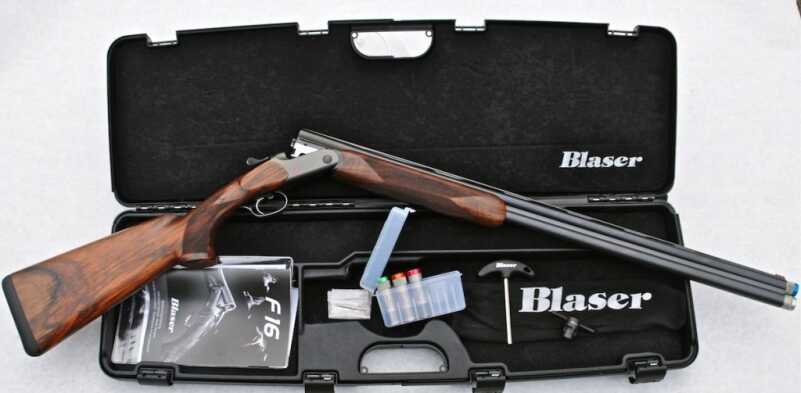
F16 Sporting comes in a lockable hard sided case with the chokes and tools needed to go straight to the range or the field.
When the dust settles the F16 owner is the winner, leveraging the F3 design achievements- gaining much and giving up little for the savings. The biggest sacrifices are that the F16 only comes in 12 ga, giving up the additional barrel modularity of the F3, and utilizes a different trigger design.
Initial Impressions
Upon initial inspection and handling of the F16 the gun felt well balanced and was a natural pointer. The machine work on the metal parts was what you would expect from a fine German firearm. The F16’s metal was completely smooth, and nicely finished; focusing on performance not frills, no engraving on this fast sleek F16.
The first stop for the Blaser was at the patterning board. If it won’t shoot where it’s aimed, I don’t care how much engineering, pretty wood, or beautiful bluing a gun has; I don’t have much use for it.
The F16 Sporting had a very low, tapered rib on it with a silver mid bead, and a fiber optic red front sight. The tapered rib, and mid bead, guide your vision down the barrel to the very bright fiber optic sight as though looking down a runway.
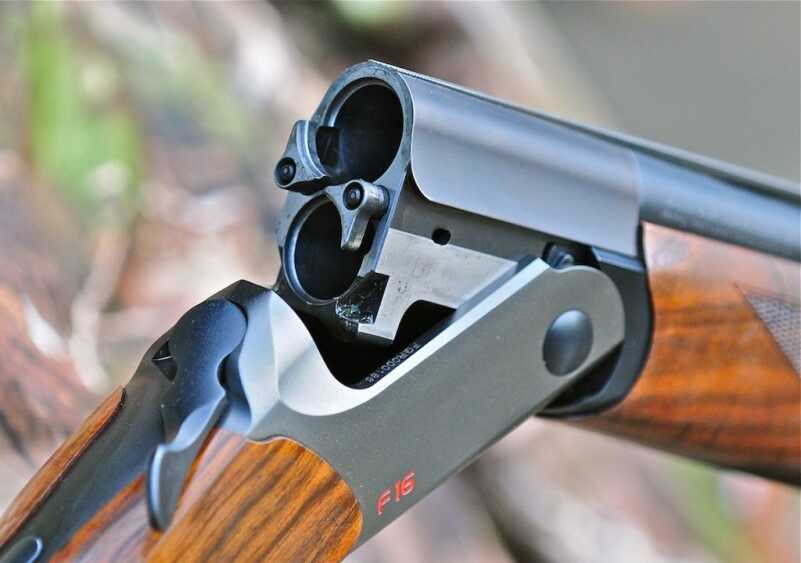
The low profile of the barrel set is evident in the photo above. The semi-round contoured receiver operates smoothly on the large hinge pins.

The wood is elegant grade 4 oil rubbed walnut, with nice checkering on the grip and forearm. The pistol grip of the stock had a nice, well fitted palm swell, giving the gun a very natural feel in your hands.
SPECS:
- Type: Break-action 12 gauge
- Overall Length- 48”
- Weight- 8 lbs
- Barrels- 30”Chrome Lined (32”available)
- Barrel Finish- Matte Blued
- Receiver Finish- Gun Metal Grey
- Selectable Barrels (forward of trigger)
- Tang Safety
- Adjustable Trigger Position
- Adjustable Stock Balance Weights
- Adjustable Barrel Balance Weights
- Length of Pull- 14 ¾”
- Drop at Comb- 1 ½”
- Drop at Heel- 2”
- Stock- Oil Rubbed Walnut
- MSRP- $4,195 (Sporting model)
The drop on the stock made it natural for me to be able to see right down the top of the rib like the stock had been fitted just for me; a feat that is not as common as I would like when evaluating shotguns.
After shooting repeated patterns at 30 yards, testing both barrels with the modified choke, I was solidly impressed. Both barrels hit exactly where the fiber optic was aimed as the shot broke and patterned densely. If I broke a shot a little high or low, that is exactly where the center of the pattern was every time.
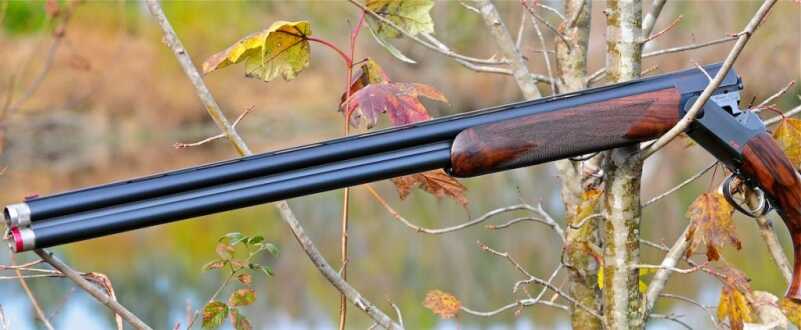
The sleek lines of the F16 bring out its simple beauty. The finishes on the metal and wood are attractive as well as functional.
The combination of chamber, forcing cone, over bore and choke tubes came together nicely. The Blaser Triplex bore design on the F16 put the pellets where they counted. I had not doubts that when I got this gun on some clays or birds, any misses would be my doing not the gun.
Ergonomics and Features
The F16 comes with 5 chokes that are delightfully color coded and labeled in large enough print that us old guys don’t have to get out the readers to see which is which. The chokes are made for Blaser by Briley Manufacturing and did a fantastic job on the patterning board and on the clay field.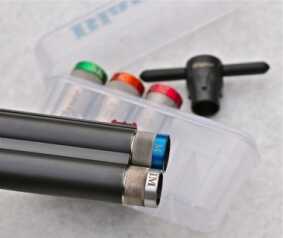
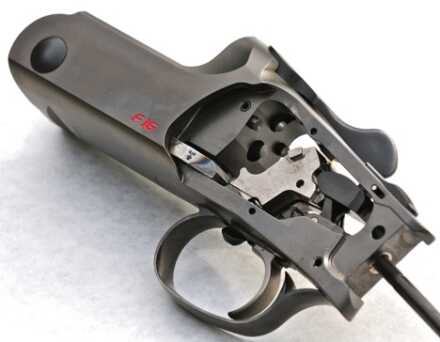
Solidly designed and built receiver. All the components within are built for long life and ease of maintenance. No stamped or fragile parts to be found anywhere on the Blaser.
The F16 has a semi- rounded low profile receiver that lowers center of gravity of the gun, and contributes to the natural pointing and balance. I can’t pinpoint exactly which element to credit for the balance and pointing characteristics, but I can say that Blaser got the combination of factors right.
The F16 utilizes the same Ejector Ball System (EBS) as its predecessor the F3. This extractor/ ejector system cocks the ejectors as the action is opened; this makes the action very smooth and noticeably easier to close.
The ejectors are activated when the shot is fired. The hammer falling is what actually activates the individual ejectors. If you only shoot one shot, it ejects that barrel and just lifts allowing extraction of the other shell. Ejection is very positive and launches spent shells 8 to 10 feet over your shoulder.The F16 does not have an adjustable comb or stock and I found I didn’t need either to shoot the F16 well. What it does have is an adjustable stock balance system that allows tailoring the rear balance of the gun to your liking. The weights are locked in place by set screws on the flat portion of the threaded positioning rod.
Weighing the Options
The number of combinations available for adding and positioning weight in the stock or along the barrel on the F16 makes it versatile enough to meet most any shooters requirements. The Allen wrenches required for adjustment of the balancing system are a part of the accessories provided with the F16.
Overall weight of the F16 tested, with 3 weights in the stock and 3 weights under the handguard was right at 8 lbs; noticeably lighter than my personal O/U. With all the weights removed it puts the 30” barrel F16 at about 7 lbs 4oz., certainly light enough to make a fine field gun as well as a fine choice on the sporting clays course.
The light weight can be attributed to the low profile, monocoque receiver, short vent rib and absence of extra material in the design. While shooting several hundred rounds I didn’t notice any significant recoil but did notice a bit more jump than normal when reviewing some of the shooting video. Recoil is managed by the nice soft Blaser recoil pad.
In addition to the weight and balance of the F16 being adjustable, so is the position of the trigger. It is locked in place by a 1.5 mm allen set screw along a guide within the trigger guard. This allows for a bit of adjustment to the length of pull without having a gunsmith carving on your stock.
The Trigger
The trigger broke cleanly between 3lbs 12oz and 4lbs 5oz , and seemed to vary slightly between first and second shot. I never felt the variance while engaging targets or patterning, only when I put the trigger gauge to it did it reveal the minor difference.
[one_half]
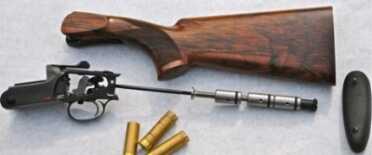
Threaded rod in the stock holds weights that can be added, removed or positioned to change the overall weight, feel and balance of the F16.
[/one_half][one_half_last]
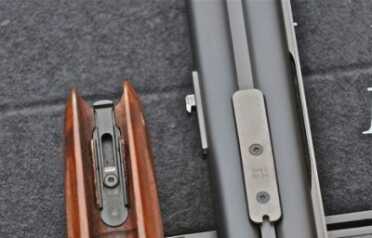
Forearm catch is nicely hidden away at the tip of forearm rather than on the bottom. 1 ½ oz barrel weights screw to the barrels under the handguard to adjust the balance of the F16. Low rib of the F16 keeps the eyes right on top of the barrels
[/one_half_last]
The trigger mechanism incorporates Blasers Inertial Block System (IBS), preventing inadvertent firing of a second shot due to fan firing.
Also located within the trigger guard is the barrel selector switch. It is forward of the trigger guard and labeled on each side to identify which barrel is selected. The labeling is engraved into the switch but is not filled in with any color so you do have to look closely to see if it’s an O or an U.
The F16 manual safety is located on the top of the receiver on the tang. I prefer the separate control for the safety and barrel selector. The safety does not auto engage when you work the action of the F16; it’s all on you to get the safety back on when you’re finished shooting. The label for Safe or Fire positions is also just engraved into the receiver and not painted or colored, so a bit of attention and caution is needed in initial operation.
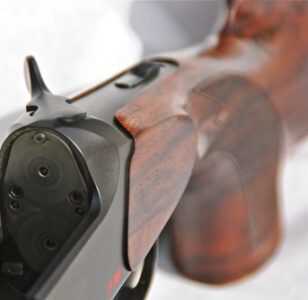
Breach face is user removable allowing access to replace firing pins. Stock sits up a bit proud around all the metal surfaces.
Range Testing
The F16 did not disappoint when challenged by a horde of crossing clays at the local skeet field. Shooting 22’s and 23’s on the skeet field was the norm right from the start, and I accept responsibility for the few that got away each round due to my lack of focus.
The excellent balance and pointability made getting on the fast-moving positions relatively easy. A true test of speed and handling, in my opinion, is out in the middle of the field on position 8. The F16 moved like a speeding jet when attacking the position 8 birds- fast, yet smooth and well controlled. Only a couple out of a dozen or more managed to get past on that tough position.
The ease at which the F16 managed to crush birds was a testament to the fit, balance, and patterning. I was using the skeet and improved cylinder chokes on these birds. There were far more solidly hit birds than those that were just chipped or barely broken.
The Good
Point of impact, patterning, feel, pointability and reliability were excellent. Tapered low profile rib design worked superbly for putting patterns where they needed to be. Balance was great, as you would expect from a gun that has an adjustable weight system in the stock and on the barrel. Performance on the range reinforced that the overall design is a great combination.
The Bad
Length of Pull was a bit long for me, but I dare say that if you are 5’ 10” or more it will fit you like a glove. Wood fit was a bit proud for my liking, but metal work inside and out was superb.
Final Thought
The F16 costs thousands less than the F3 and is a fantastic gun in its own right. It’s a great design exhibiting superior craftsmanship. It gives up little and delivers every bit of what is expected. I put one of the 32” Sporting models on my Christmas list for Santa.
For more information about Blaser firearms, click here.
***Check out GunsAmerica for your next shotgun.***

\”…as a shotgun that delivers performance and innovation, but at a significantly more affordable cost.\” Affordable at $4,200? Seriously? Yes, it is a beautiful gun and in a most under-rated gauge, for sure.. But for forty-two-hundred bucks I could buy a couple of $1,000 guns and easily pay for a weeklong combination duck-upland bird hunt to the Dakotas or maybe a dove hunt in Texas or even Old Mexico… Those two last options make a lot more sense…
Suggested retail price of the F16 Blazer ?
They start at $4,000. Not really a beginner shotgun
$6 large pluss
MSRP- $4,195 (Sporting model), right there in the article.